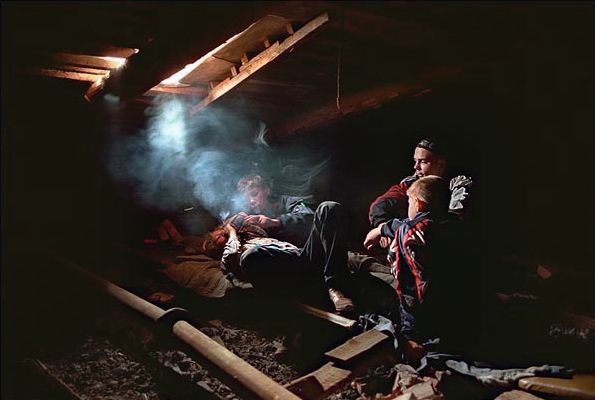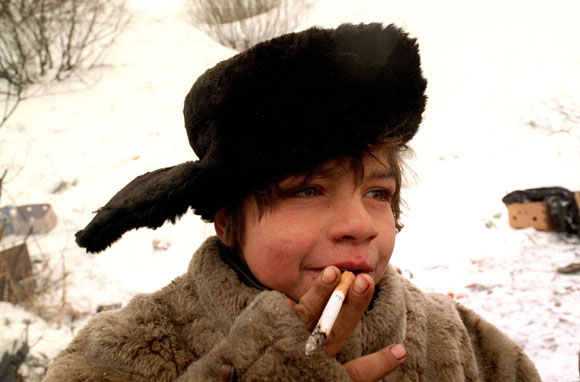Portrait of a Homeless Child
In 2003, the Center for Demography and Human Ecology of the Institute of Economic Forecasting (Russian Academy of Sciences) released a report on homeless children. The Center's report provided the portrait of a typical Russian street child. The average age was estimated at 12-13; two-thirds of homeless children were boys, 50% were migrants.

“The attics and basements of apartment buildings in the center of St. Petersburg provide shelters for dozens of groups ‘cliques’ of homeless children. As a rule, each clique has between 5 and 10 children. They range from 10 to 17 years old. The younger ones are better at making money than the older ones. They do better begging. The older ones protect them and arrange the ‘household,’” says renowned photojournalist Sergey Maksimishin. Photo by Sergey Maksimishin.
According to the polls, which were conducted among homeless children, there were three main reasons why children and teenagers chose vagrancy. The first and the most common one was that one or both of their parents had a drinking problem. This cause was cited by 40.5% of respondents. The second most common reason was not having one or both parents; the third was domestic violence. Overall, the key issue for all of the children was a dysfunctional family. As the Moscow Helsinki Group reported, about 2 million children under 14 years old suffer abuse at the hands of their family members annually, and about 50 thousand run away from home.
A 2006 UNICEF study on homeless children in developing countries provides one with a good idea of a child's life on the street. Almost 50% of homeless children start working at the age of 10 and 11, and nearly 10% when they are between the ages of 5 and 7. Typical employment includes activities such as begging, collecting bottles, cleaning, and helping at street markets. By the time they are 11, homeless children often become drug addicts, many become involved in criminal activities, and a number are roped into prostitution when they are as young as 5.
As the experts from the Center for Demography and Human Ecology report, street children grow up fast. The Center's polls show that two-thirds had smoked cigarettes and imbibed alcoholic beverages, while about one-third of them had taken drugs and engaged in sexual activities. Eighty percent have various diseases and mental disorders; 20% are illiterate.
Eighty-five percent of homeless children in Russia are so-called social orphans, whose parents are alive, but either deprived of their parental rights, in prison, or chemically dependent on drugs or alcohol. According to Pavel Astakhov, the Children's Rights Commissioner for the President of the Russian Federation, an estimated 50-60 thousand Russian citizens have had their parental rights terminated.
A Policy of Non-Involvement
In 1999, Russia passed the bill “On the Prevention of Homeless Child Vagrancy” which named a number of government agencies responsible for implementing new regulations. These are Ministry of Internal Affairs (MVD), Ministry of Health, and the Ministry of Education. This bill took the homeless children from under the MVD’s direct supervision, thus prohibiting the police from placing them in juvenile detention centers. As a result, law-enforcement authorities have adopted the practice of not involving themselves in the lives of the street children unless a child commits a crime. This also means that their statistics only account for the homeless children that were brought in and registered at police stations (which is about two-thirds of their total population). The new bill didn’t specify the exact responsibilities of each respective government agency, and in reality, leaves the homeless children, well, neglected.
Then, in 2002, the problem of homeless children suddenly reappeared on the state agenda. Early that year Valentina Matviyenko, the former Deputy Prime Minister, announced that the number of homeless children in Russia had reached 1 million. The MVD and the General Prosecutor's Office followed up by publishing their own reports, estimating the numbers to be as high as 2-2.5 million. Then, in his annual address to the Federal Assembly, President Vladimir Putin called the increasing number of the homeless children “a threat to national security.” He also initiated a federal program for fighting this problem called Prevention of Youth Homelessness and Delinquency, which was in effect between 2003 and 2006. One of the program's important components was launching an interagency commission for coordinating the measures targeted at resolving the issue of child homelessness. Boris Gryzlov, then the Minister of Internal Affairs, was appointed the chair of this commission. However, with the exception of a single report, dated 2002, there is no publicly available information on the commission's activities.
Nonetheless, the information contained in this report is quite curious and worth noting. 1.2 billion rubles were allocated in the course of the implementation of this subprogram. But the impact of the projects appears meager. Here are some of them:
"Developing and broadcasting a series of programs (4) on Mayak Radio aimed at raising awareness on the prevention of youth homelessness."
"Purchasing 500 washing machines, delivering them to 243 social rehabilitation centers, 86 centers for social assistance to family and children, 11 social service centers (children’s departments) in 69 districts of the Russian Federation."
"Organizing 7 field-oriented camps in 7 districts of the Russian Federation. 2780 children from 15 districts of the Russian Federation can participate in camp activities."
You don’t need to be an expert to understand that these measures only provide for the minimal improvement in the quality of life for institutionalized children. Moreover, the measures were temporary in nature, and essentially, do nothing to solve the problem.

The federal law "On The Prevention of Youth Homelessness and Delinquency" (edited January 13, 2001 #1_FL, and on July 7, 2003 No.111_FL) includes the following definitions for 'neglected child' and 'homeless child': "A neglected child is a minor whose activities are not supervised due to the neglect of the responsibility for his/her behavior, education, and/or allowance, or due to the improper fulfillment of such obligations on the part of the child's parents or legal guardians; a homeless child is an unattended child who has no place of permanent or temporary residence."
In 2005, the MVD tried to tackle the problem itself. This time, it was the new Minister of Internal Affairs Rashid Nurgaliyev who gave a detailed interview on the subject to Shield and Sword, a ministry-sponsored publication. In this interview, Nurgaliyev acknowledged that problems in the family are the most important contributing factor to children running away. “For many years, we have been ignoring the fact that dysfunctional families, domestic abuse, and sometimes full-scale child abuse exist in our society. Unfortunately, these problems are common in Russia. Today, it is our responsibility to speak out not only about the material, but also the moral impoverishment of the majority of the Russian families.”
Nurgaliyev pointed to such key problems as the lack of a single coordinating government agency that could supervise homeless children, which leads, in his words, to insufficient data on their real numbers and, consequently, to the inconsistency in the government services available to them. In order to overcome these problems, Nurgaliyev offered to establish a federal database for the purposes of “assessing the scale of the problem and defining the volume and kind of real measures that could positively impact the situation.”
It's also worth mentioning that Mr. Nurgaliyev has shown at least some consistency in this regard, periodically returning to this issue in his public addresses. In May 2007, at the session of the MVD’s Public Council, the minister announced that there were 730 thousand homeless children in Russia, and called for the creation of a council that would include members of the public, human rights, and religious organizations to cooperatively fight against child homelessness in their individual realms. Somehow, his words sounded like a declaration of the helplessness of the law-enforcement authorities in the face of this problem.
In September of the same year, the Duma organized a "government hour"—part a series of roundtable discussions between various government officials, Duma Deputies, and experts–on children in Russia. The issue of homelessness was included on the agenda. The Ministers of Health and of Education—Mikhail Zurabov and Andrei Fursenko, respectively—came to meet with the Duma deputies. One of the deputies demanded to know why Dzerzhinsky had managed to solve the problem with homeless children in three years in the 1920s, while the current ministers were incapable of doing so. Zurabov dismissed the criticism, saying that questions about Dzerzhinsky should not be addressed to him. Fursenko ignored the question as well, although later, he stated that information circulating in the media about the millions of homeless children in Russia is exaggerated. He also said that by 2010, the number of state-run orphanages should be decreased by one-quarter.
In October 2008, Nurgaliyev suggested that mandatory treatment for alcoholism should be introduced in Russia, since the problem, in his words, is “a national issue that has an impact on the crime rate,” and often causes children to leave their homes. This suggestion raised a number of objections from human rights organizations and, in the end, was not implemented. At the same time, Nurgaliyev insisted on the more active implementation of the recently-introduced state social welfare workers whose job was engaging directly with disadvantaged families. Their work was aimed at preventing domestic violence. The federal position of social welfare workers was introduced in a number of Russian districts, but as a result of the recent police reform, their number was reduced by half.












